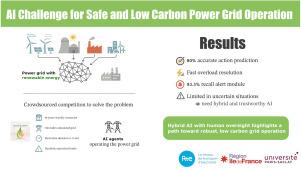AI challenge for safe and low carbon power grid operation
IF 9.6
Q1 COMPUTER SCIENCE, ARTIFICIAL INTELLIGENCE
引用次数: 0
Abstract
Achieving carbon neutrality by 2050 will require power-grid operators to absorb unprecedented volumes of variable solar and wind generation while maintaining reliability. To tackle this systems-level bottleneck, Réseau de Transport d’Électricité (RTE) and the research community launched Learn To Run A Power Network (L2RPN), a crowd-sourced competition aiming to accelerate the integration of intermittent renewables into power-grid operations. L2RPN is based on 16 years of weekly scenarios (832 in total) on a 118-node grid under realistic constraints, and casts real-time grid operation as a Markov-Decision-Process. The six participating teams tackled the challenge by developing autonomous agents with various strategies blending heuristics, optimization, data scaling, supervised learning, and reinforcement learning. We provide a detailed overview of all six participants’ performance under the competition’s demanding design. In addition, we present an in-depth analysis of the winning solution – made publicly available – which achieves consistent decision making across scenarios, executes real-time multimodal actions in under five seconds, and performs efficient topology control via action-space reduction and a neural policy that predicts useful grid actions with over 80% accuracy. In parallel, we trained a neural alert module on 315,000 samples derived from top agents, achieving 93.9% recall in flagging dangerous states and allowing agents to predict future failure. Finally, this work not only demonstrates AI’s promise and current limits in real-time grid management but also lays a transparent foundation for more robust, trustworthy systems in the energy transition.

人工智能对电网安全低碳运行的挑战
到2050年实现碳中和将要求电网运营商在保持可靠性的同时吸收前所未有的可变太阳能和风能发电量。为了解决这一系统级瓶颈,RTE和研究界发起了学习运行电网(L2RPN),这是一项众源竞赛,旨在加速将间歇性可再生能源整合到电网运营中。L2RPN基于现实约束下118节点网格上16年的每周场景(总共832次),并将实时网格操作转换为马尔可夫决策过程。六个参赛团队通过开发具有各种策略的自主代理来应对这一挑战,这些策略混合了启发式、优化、数据缩放、监督学习和强化学习。我们提供了所有六名参与者在比赛苛刻设计下的详细表现概述。此外,我们对获胜的解决方案进行了深入的分析,该解决方案实现了跨场景的一致决策,在五秒内执行实时多模态动作,并通过动作空间缩减和神经策略执行有效的拓扑控制,预测有用的网格动作的准确率超过80%。与此同时,我们对来自顶级智能体的315,000个样本进行了神经警报模块的训练,在标记危险状态时实现了93.9%的召回率,并允许智能体预测未来的故障。最后,这项工作不仅展示了人工智能在实时电网管理方面的前景和当前的局限性,还为能源转型中更强大、更值得信赖的系统奠定了透明的基础。
本文章由计算机程序翻译,如有差异,请以英文原文为准。
求助全文
约1分钟内获得全文
求助全文
来源期刊

Energy and AI
Engineering-Engineering (miscellaneous)
CiteScore
16.50
自引率
0.00%
发文量
64
审稿时长
56 days
 求助内容:
求助内容: 应助结果提醒方式:
应助结果提醒方式:


